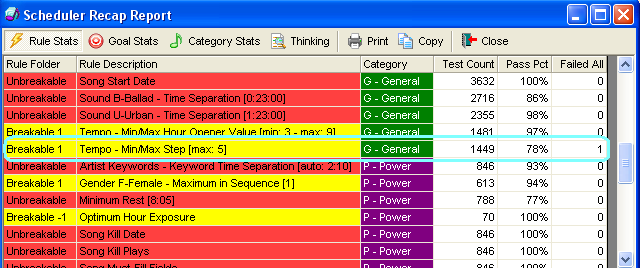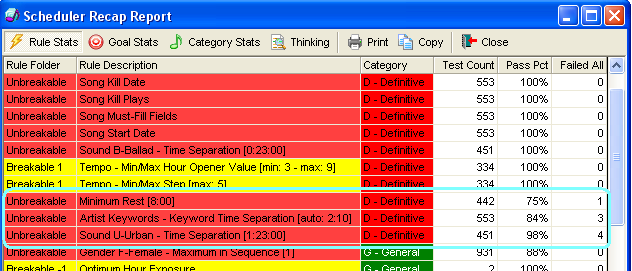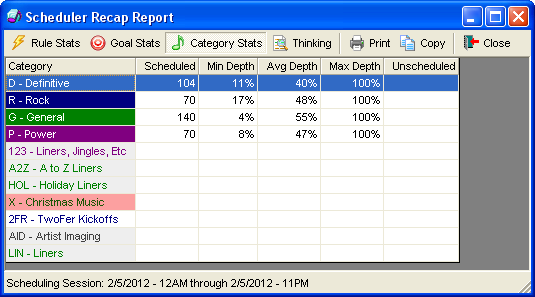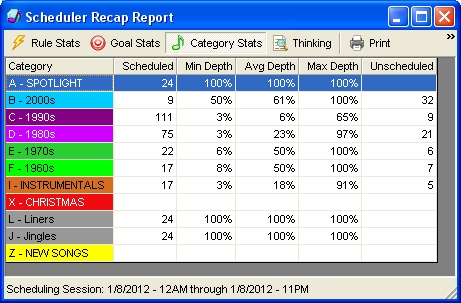MusicMaster Blog
How to Read the Recap Report posted on August 6th, 2012
by Paul Ziino
The Scheduling Recap Report (Dataset/Schedule/Recap Report) is a great tool for determining which unbreakable rules are causing unscheduled positions in your log as well as which breakable rules are being violated.
Run the Automatic Scheduler as you would normally. When it is done, view the Recap Report. As you look through the categories you will see every rule tested by the Automatic Scheduler is listed by category, and each rule is followed by three columns: Test Count, Pass Pct, and Failed All.
Test Count is the number of times that test was attempted for that category. If you have a depth of 100 songs in a category and MusicMaster has to test all 100 of those songs against a given rule every time it attempts to fill a position for that category in the log, and you schedule that category 5 times per hour, you could expect to see a number up to 12,000 for a single day. For categories with smaller depths and fewer positions, that number would be much smaller. Also, later-testing rules will likely have lower Test Counts since each rule filters out songs that violate it.
Pass Pct indicates how difficult a rule is. The higher the number, the easier it is for MusicMaster to schedule based on that rule. By default, MusicMaster will list any Pass Pct of 50% or lower in red. You can change that in Tools/Options/Additional Properties, then under the Schedule header find RecapMinPerformance and adjust it accordingly.
For a breakable rule, Failed All indicates the number of positions that were filled yet violated that breakable rule. In the following example we see that in category G we tested the Breakable Tempo Min/Max Step rule 1449 times, it passed 78% of the time, and there is one scheduled position in the log that violates this rule.

Let’s look at the recap report below. You’ll see that in category D, we have an unbreakable Minimum Rest rule of 8:00. You’ll see that rule was tested 442 times and that it has a Pass Pct of 75% and Failed All equals 1. This means that of the 442 times Minimum Rest was tested in the D category, it passed 75% of the time and since this is an Unbreakable rule, it caused 1 unscheduled position in the scheduling session.

Furthermore, we can see that the unbreakable Artist Keyword Time Separation rule of 2:10 was tested 553 times, of which it passed 84% of the time and caused 3 unscheduled positions. The Urban Sound Code caused 4 unscheduled D positions in the last scheduling session.
Just because an unbreakable rule shows a Failed All count does not always mean it caused an unscheduled position. For example, if you are using Migrating or Combo clock elements, it is possible to have a Fail All number but no unscheduled position. This is because Migrating and Combo elements allow for multiple categories to be tested in a single position. Looking at the above example we would assume there are a total of 8 unscheduled Ds in the last scheduling session. However, if D was not the last category tested for those positions, you could potentially have zero unscheduled items in that log.
We can also look at the Goal Stats via that icon. This lists all Optimum Scheduling Goals in place and indicates how many times they came into play. Looking at the sample below we can see that in category D the only goal in place is Optimum Hour Exposure (as is the case in all categories listed). Of the 104 times a scheduled position was tested against this goal, the Min Value was 57% which means the song was exposed to at least 57% of the broadcast hours. On average (Avg Value) the song was exposed to 88% of the broadcast hours, and at some point in the last scheduling session there was a song that was exposed to all broadcast hours (Max Value of 100%).

The Category Stats icon takes you to an overview of how many positions were scheduled for each category in the last scheduling session, and how many of those positions were filled by the automatic scheduler. In the following sample we see the D category was scheduled 104 times and that MusicMaster tested at least 11% of the depth in order to find the song that was scheduled, had to dig an average of 40% to find a song (Avg Depth) and at least one time had to go through the entire depth (Max Depth of 100%) in order to schedule a position. We also see that there were no unscheduled positions remaining for any category in the session.

Looking at the next example, it would appear that we have a total of 80 unscheduled positions in the scheduling session. However, because this database uses Migrating elements in the clocks, there are actually far fewer unscheduled positions. In this case, we had 32 B positions that were not filled by category B. Those positions could have been filled by other categories that were allowed to Migrate in those clock positions.

If you’d like to learn more, you can view our article about Migrating Clock Elements as well as our article about Combo Clock Elements.
The next icon available in the Scheduler Recap Report is for the Thinking file. The Thinking file gives a position-by-position breakdown of every song tested and why it was either selected or skipped by the automatic scheduler. The Thinking file is another great tool for determining exactly what is happening in the automatic scheduler. Your Music Scheduling Consultant can help you decipher the Thinking file should you need it.
The Recap Report and its details can be printed or copied to the clipboard via the appropriate icons.
MusicMaster can open the Recap Report for you after scheduling. When you start the Automatic Scheduler, click the Options tab and check the box to “Show recap report after scheduling”. (It’s not a bad idea to also check the boxes to “Save thinking process to disk” and to “Launch Schedule Editor after scheduling” too!)
Next time you’re trying to determine why things are scheduling the way they are, take a look at the Recap Report. It’s a valuable tool to keep in your scheduling work belt!
